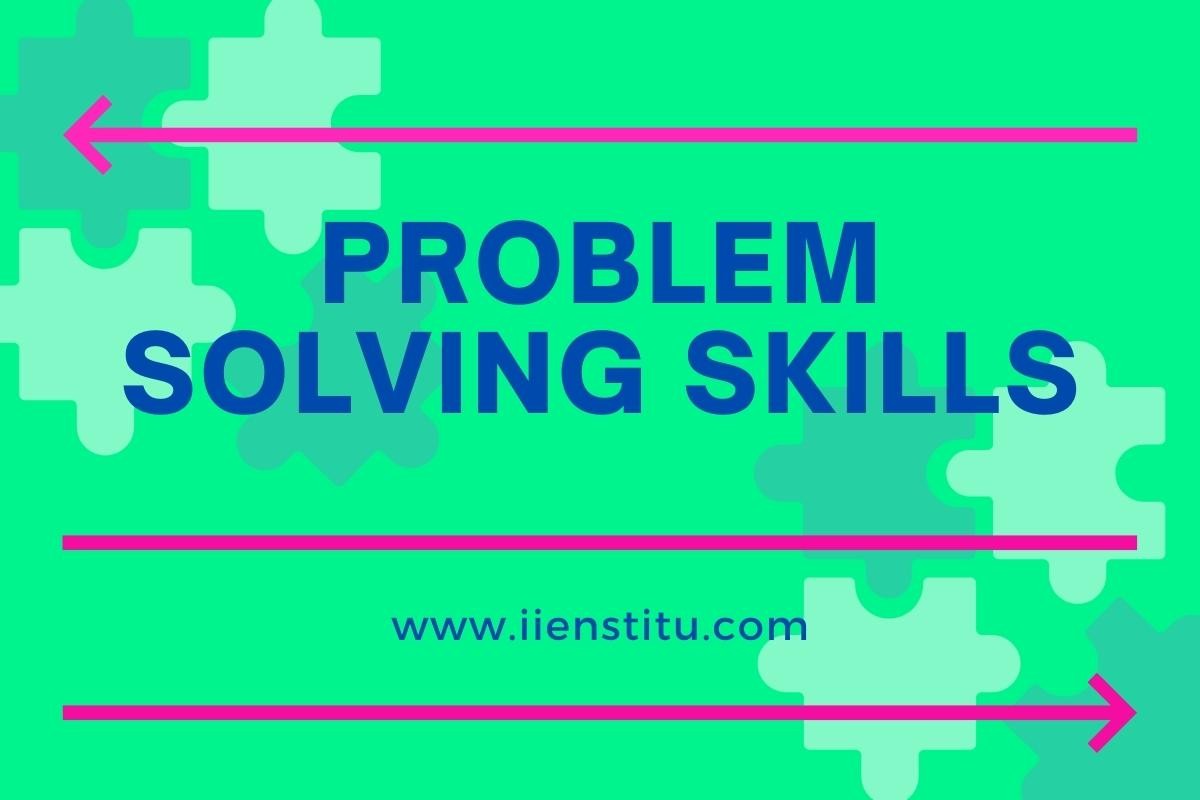
This article discusses lateral thinking, a problem-solving technique that encourages creative solutions by looking at a problem differently. It explains the role of lateral thinking in problem-solving and how it can be used to find the needle in the haystack.
It encourages creative thinking by challenging traditional ways of thinking and finding solutions and is often used in business and educational settings. The article provides examples of lateral thinking, such as digging a hole and researching cancer, to illustrate the concept. It also discusses the need for lateral thinking when finding the needle in the haystack and how it can help you find it by looking at the problem from a different angle and considering different approaches to solving it.
Introduction
Definition of Lateral Thinking
Overview of Problem-Solving
Lateral Thinking and Problem-Solving
Digging a Hole
Problem-solving is an integral part of everyday life. We are constantly presented with problems that require creative solutions. Lateral thinking is a problem-solving technique that can help us find solutions to complex problems. In this article, we will discuss the definition of lateral thinking, its role in problem-solving, and the need for lateral thinking when finding the needle in the haystack.
Definition of Lateral Thinking
Lateral thinking is a problem-solving technique that encourages creative solutions to problems. It involves looking at a problem from a different angle and coming up with a solution that is not immediately obvious. It encourages creative thinking by challenging traditional ways of thinking and finding solutions. It is often used in business and educational settings to help people think outside the box and develop new, innovative solutions.
Overview of Problem-Solving
Problem-solving is the process of finding a solution to a problem. It involves analyzing the problem, identifying potential solutions, and evaluating and selecting the best solution. Problem-solving can be done individually or as a group. It is an essential skill for success in many areas of life, such as business, education, and personal relationships.
Lateral Thinking and Problem-Solving
Root Cause Tree Analysis: Insights to Forensic Decision Making
Process Mapping: A Comprehensive Guide to Efficient Workflow Management
Digging a Hole
The metaphor of digging a hole is often used to illustrate the concept of lateral thinking. If you have been digging a hole in a particular thinking and problem-solving domain for a long time, you have made the hole more profound and comprehensive.
At some point, you may decide to start digging in another location, a lateral location. This is the concept of lateral thinking. It involves looking at the problem from a different angle and coming up with a solution that is not immediately obvious.
Researching Cancer
Another example of lateral thinking is when researching the field of cancer. If you have been focusing on radiation treatment for prostate cancer, you may switch to a different, lateral approach. This could be chemotherapy, immunotherapy, or surgical therapy. Lateral thinking encourages you to consider different approaches to a problem rather than sticking to the same old methods.
The Needle in the Haystack
Finding the Haystack
The metaphor of the needle in the haystack is often used to illustrate the difficulty of finding a solution to a problem. In this case, the needle is the solution, and the haystack is the problem. Finding the solution requires creative thinking and lateral thinking. Simply looking for the needle is not enough; you must also find the haystack.
Lateral Thinking as a Solution
Lateral thinking can help you find the haystack. It encourages you to look at the problem from a different angle and consider different approaches to solving it. It also encourages you to think outside the box and come up with creative solutions. It is important to remember that lateral thinking is not a magic wand but a tool that can help you find the solution.
Conclusion: Lateral thinking is a powerful tool for problem-solving. It encourages creative thinking and helps you find solutions to complex problems. It also helps you find the needle in the haystack by encouraging you to look at the problem differently. Lateral thinking can help you find creative solutions that you may not have considered before.
Imagination is the key to unlocking creative solutions; lateral thinking is the key to finding them.
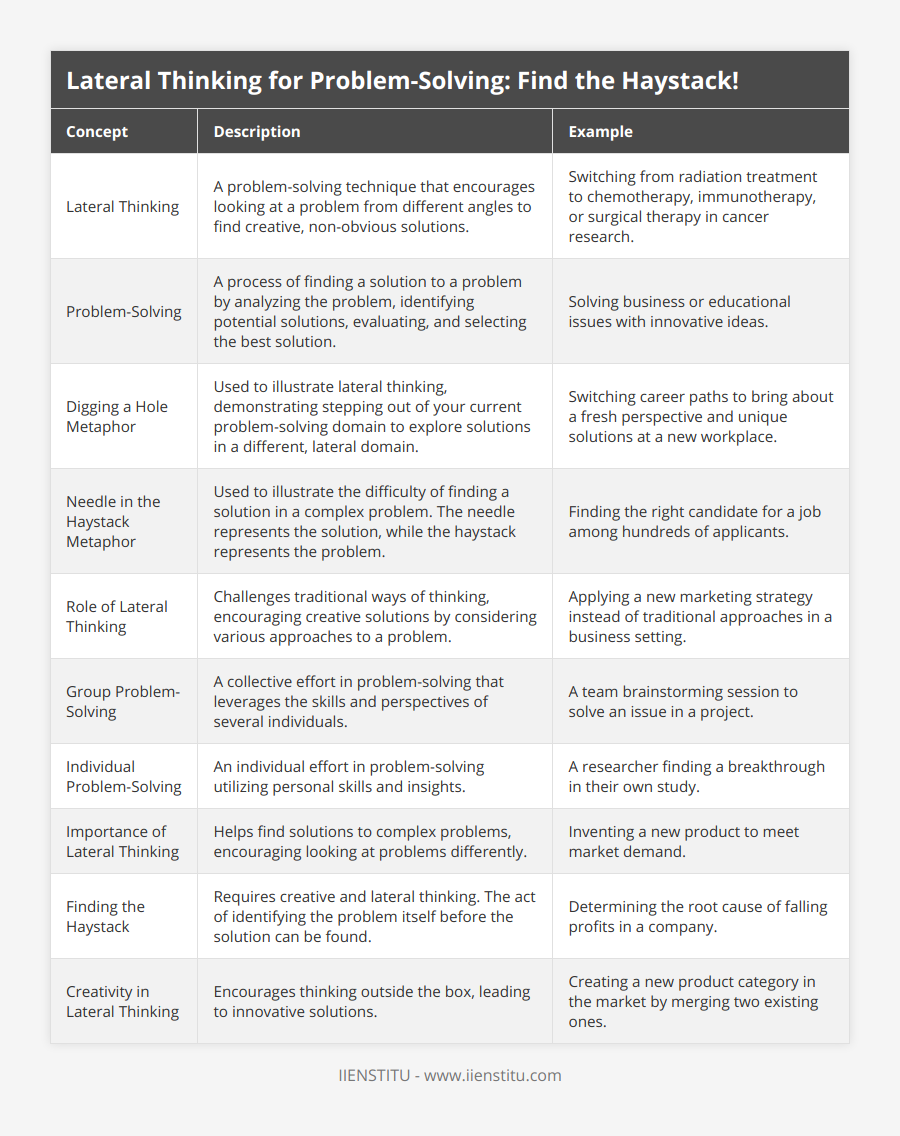
Frequently Asked Questions
What is lateral thinking and how can it be used to solve problems?
Lateral thinking is a problem-solving approach that encourages creativity and divergence from conventional solutions. It involves looking at a problem from different angles, questioning assumptions, and seeking to identify non-linear solutions. It is a valuable tool for problem-solving, as it enables us to find new ways of looking at the same problem and uncovering solutions that may not have been considered previously.
Edward de Bono first coined the term lateral thinking in 1967; it has become an essential part of problem-solving. It is based on the idea that there may be multiple solutions to a problem and that we should be open to exploring unusual or unconventional ideas. It is often used to break out of the “box” of conventional problem-solving and to open up new possibilities.
Lateral thinking can be applied to any problem-solving situation, from personal to business challenges. It involves looking at the problem from different perspectives, questioning assumptions, and searching for solutions outside the standard “box.” It encourages divergent thinking and encourages us to think “outside the box”.
Several techniques can be used to apply lateral thinking to problem-solving. These include brainstorming, mind mapping, and forcing relationships. Brainstorming involves coming up with as many ideas as possible without judging them and then narrowing them down to the best solutions. Mind mapping involves visualizing the problem and looking for ways to connect the different elements. Forcing relationships involves forcing relationships between elements to uncover new solutions.
Lateral thinking can be a powerful tool for problem-solving. It encourages us to think outside the box and develop creative solutions. It can be used in any problem-solving situation, from personal to business challenges. By applying these techniques, we can uncover new solutions and possibilities.

What are the benefits of using lateral thinking for problem-solving?
Lateral thinking is a problem-solving method that encourages creative and unconventional solutions to problems. It is a valuable tool that can be used to help think outside the box and come up with innovative solutions to complex problems. This article will discuss the benefits of using lateral thinking for problem-solving.
One of the main benefits of using lateral thinking for problem-solving is that it encourages creative and innovative solutions. By challenging the traditional ways of thinking and approaching problems, lateral thinking allows for a more excellent range of potential solutions. Furthermore, lateral thinking encourages creativity, which can be beneficial in many aspects of life.
Another advantage of using lateral thinking for problem-solving is that it can help to break down complex problems into more straightforward tasks. Breaking down a problem into smaller components makes it easier to identify the underlying cause and develop a more effective solution. Furthermore, lateral thinking can also help identify potential solutions that may not have been considered.
In addition, lateral thinking can help reduce the time required to come up with a solution. Considering a range of potential solutions can lead to a more efficient problem-solving process. Furthermore, lateral thinking can help to identify the most effective solution in a shorter amount of time.
Finally, lateral thinking can help to foster collaboration and teamwork. By considering a range of potential solutions, it can be easier to identify which solution is the most effective, leading to a better outcome. Furthermore, lateral thinking can help to stimulate discussion among team members and lead to a more productive problem-solving process.
In conclusion, lateral thinking can be a valuable tool for problem-solving. It encourages creative and innovative solutions, helps to break down complex problems into more straightforward tasks, reduces the amount of time required to come up with a solution, and fosters collaboration and teamwork. Therefore, it is a valuable tool that can be used to help solve complex problems.
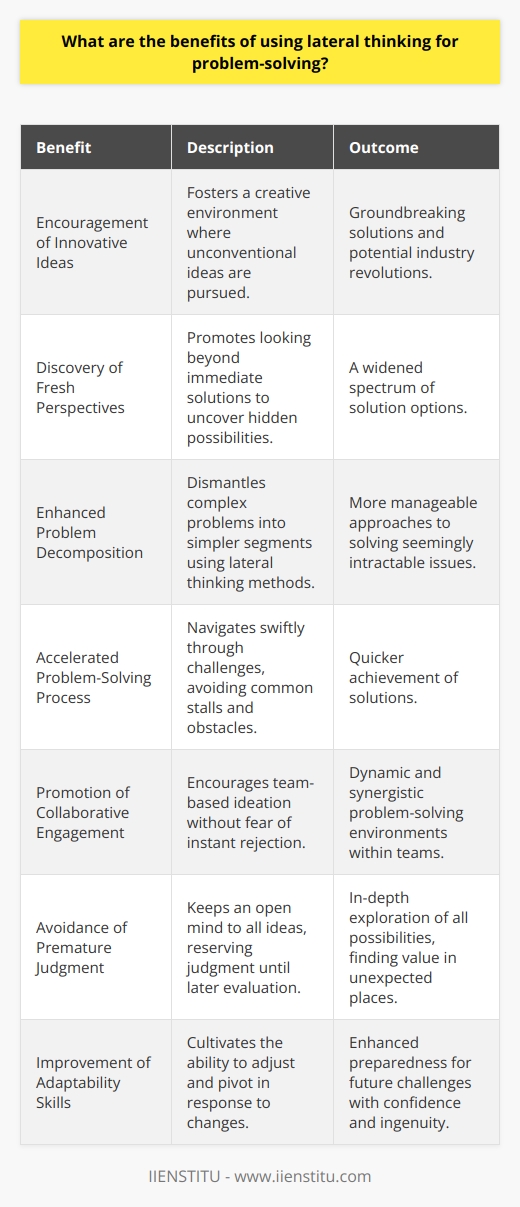
How can lateral thinking help to find the needle in the haystack?
Lateral thinking is a problem-solving technique involving thinking outside the box to find creative solutions to complex problems. It is often used to find the proverbial “needle in the haystack”; that is, to find a solution to a problem when all other avenues have been exhausted. In this article, we will explore how lateral thinking can be used to find the needle in the haystack.
At its core, lateral thinking is about asking questions from different perspectives. This can be done by breaking down the problem into its parts and looking for fresh ways to approach it. This could involve exploring the problem differently or looking for connections between seemingly unrelated concepts. By doing this, we can often uncover new solutions and ideas that have gone unnoticed by traditional problem-solving techniques.
For example, when trying to find the needle in the haystack, lateral thinking could involve asking questions like: Are there any patterns in the haystack that could help us identify the needle? Is there a way to use technology to detect the needle? Could we use a magnet to find the needle? We can help uncover hidden solutions that could lead to the needle by asking questions like these.
In addition to asking different questions, lateral thinking encourages us to think creatively. We can use our imagination to develop creative solutions to help us find the needle. For example, we might devise an idea to use a metal detector to find the needle or an algorithm to analyze the haystack and identify patterns that could lead to the needle.
Finally, lateral thinking can help us to look at a problem from a different perspective. This means we can look for new ways to approach the problem and find solutions that we may have overlooked. For example, if we were trying to find the needle in the haystack, we might ask ourselves, “What would a bird see if it were looking for the needle?” We can help uncover creative solutions and ideas that could lead to the needle by asking questions like this.
In conclusion, lateral thinking can be a powerful tool for finding the needle in the haystack. By asking different questions and thinking creatively, we can uncover new solutions and ideas to help us find the needle.

What are the 4 principles of lateral thinking?
Understanding Lateral Thinking
Lateral thinking is a problem-solving approach that encourages creative and out-of-the-box solutions. Developed by Edward de Bono in the 1960s, it encompasses four primary principles: recognizing dominant ideas, searching for alternatives, challenging assumptions, and generating innovative solutions.
Recognizing Dominant Ideas
The first principle emphasizes understanding existing thought patterns and identifying the dominant ideas that govern our way of thinking. By discerning the prevailing perspectives, we can better recognize the limitations they impose and seek to overcome them through alternative means.
Searching for Alternatives
Secondly, lateral thinking encourages individuals to actively search for multiple alternative solutions instead of settling for the most obvious one. This broadens our understanding of the problem and increases the likelihood of discovering a more effective or creative solution.
Challenging Assumptions
The third principle involves questioning established assumptions and conventional wisdom. Lateral thinkers do not take existing beliefs and norms for granted; instead, they challenge and scrutinize them, opening up new possibilities and paths of exploration.
Generating Innovative Solutions
Lastly, the essence of lateral thinking encompasses the creation of innovative and unconventional solutions. By applying the previous principles, lateral thinkers are able to generate unique and out-of-the-box ideas by connecting seemingly unrelated concepts, thus breaking free from traditional mental constraints.
In conclusion, lateral thinking principles can greatly expand an individual's problem-solving capacity by promoting creativity and innovation. By recognizing dominant ideas, searching for alternatives, challenging assumptions, and generating innovative solutions, lateral thinkers can overcome conventional limitations and unleash their full intellectual potential.
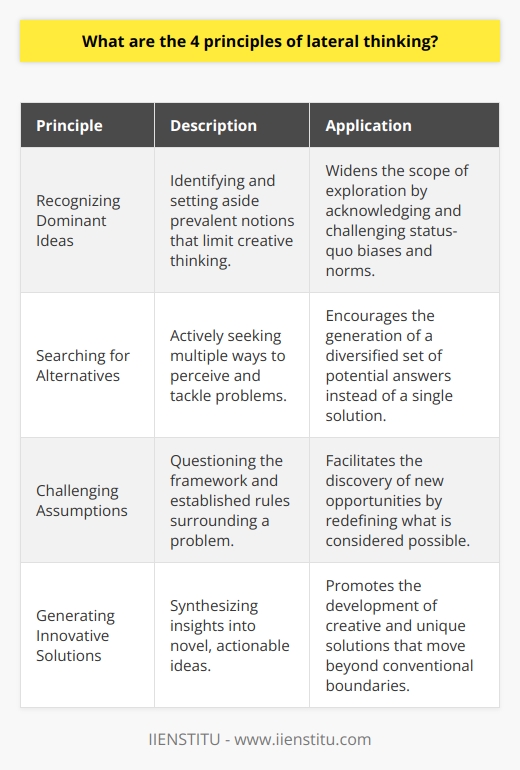
What are the 5 methods of lateral thinking?
Five Methods of Lateral Thinking
**1. Random Entry Method**
The random entry method is an essential lateral thinking technique where a seemingly unrelated word or idea is introduced into the problem-solving process. By incorporating this disconnected concept, individuals can break free from conventional thinking patterns and develop innovative solutions.
**2. Provocation and Movement**
In this strategic approach, intentional provocations are employed to challenge traditional thinking and assumptions. Once a provocative statement has been introduced, individuals move forward by identifying the valuable aspects of the idea, using this innovative perspective to generate unique solutions.
**3. Challenge Existing Assumptions**
Lateral thinking involves questioning the status quo and examining the underlying assumptions that may hinder creative problem-solving. By challenging these assumptions, individuals can remove constraints and explore alternative perspectives, fostering innovation and adaptability.
**4. Concept Extraction**
This method focuses on identifying the core concepts of a problem and considering them separately from the prevailing context. By extracting these essential elements, individuals can reconstruct the problem or situation while encouraging out-of-the-box thinking and fostering novel approaches to problem-solving.
**5. Alternate Outcomes**
The alternate outcomes method encompasses imagining different endings or results for a given situation. By considering various possibilities, individuals can gain new insights and perspectives, helping to facilitate creative thinking and enhanced problem-solving capabilities.
In conclusion, lateral thinking constitutes a set of unique techniques to approach problem-solving from unconventional perspectives. By employing methods such as random entry, provocation and movement, challenging assumptions, concept extraction, and alternate outcomes, individuals can break free from traditional thinking patterns and generate innovative solutions. As a result, lateral thinking plays a crucial role in promoting adaptability and fostering creativity in academic and professional settings.
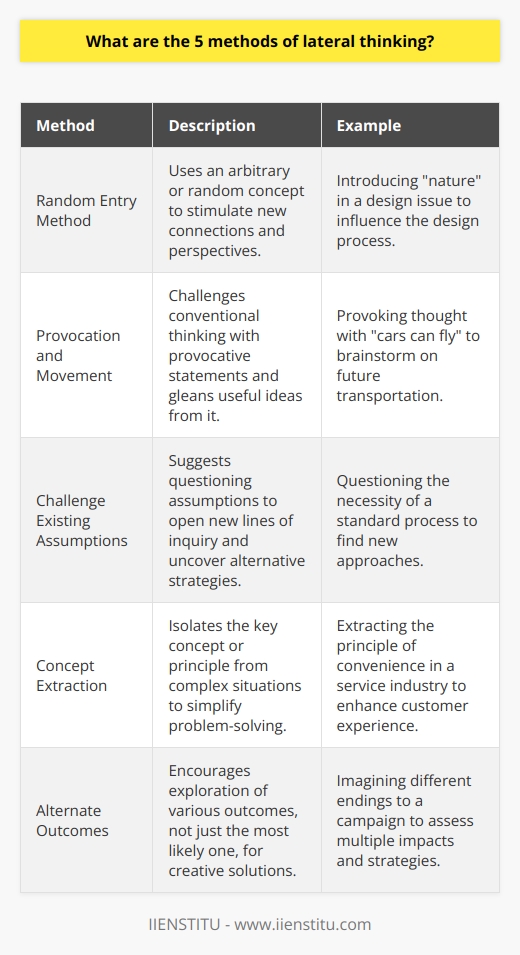
What is lateral thinking for problem-solving?
Understanding Lateral Thinking
Lateral thinking for problem-solving is a creative approach that aims to generate innovative ideas and solutions by encouraging the thinker to look beyond conventional paradigms. This method contrasts with linear, logical, or vertical thinking, which focuses on progressing systematically and sequentially toward a solution.
The Power of Divergent Thinking
In lateral thinking, divergence is paramount. Individuals are encouraged to explore various possibilities, examining multiple alternatives, and generating unconventional ideas. Divergent thinking empowers individuals to challenge traditional assumptions, enhancing their ability to find innovative solutions tailored to the unique circumstances of a given problem.
The Role of Provocation
Provocation is a crucial technique in lateral thinking. It involves intentionally introducing an outrageous or irrational idea to disrupt established patterns, thereby opening the door for novel perspectives. Through provocation, individuals and teams are nudged away from their comfort zones and invited to examine issues from a fresh standpoint, allowing new ideas to flourish.
Brainstorming and Ideation
Brainstorming is an essential tool for encouraging lateral thinking. In a brainstorming session, participants are encouraged to propose as many ideas as possible, regardless of their perceived feasibility. The main goal is to create an open and supportive environment where individuals are free to express their thoughts without fear of judgment or criticism, thus fostering the development of original concepts.
Random Input Technique
One particularly effective lateral thinking technique is the random input method, where individuals incorporate unrelated elements into the problem-solving process. By juxtaposing disparate concepts or objects, practitioners can establish previously unseen connections, uncover hidden patterns, and gain new insights instrumental in resolving complex issues.
In Conclusion
Lateral thinking is a powerful tool for problem-solving, allowing individuals and teams to break free from established mindsets and explore diverse avenues. By embracing divergence, provocation, brainstorming, and random input, lateral thinkers can cultivate the innovative and flexible perspectives necessary for tackling complex challenges in an ever-evolving world.
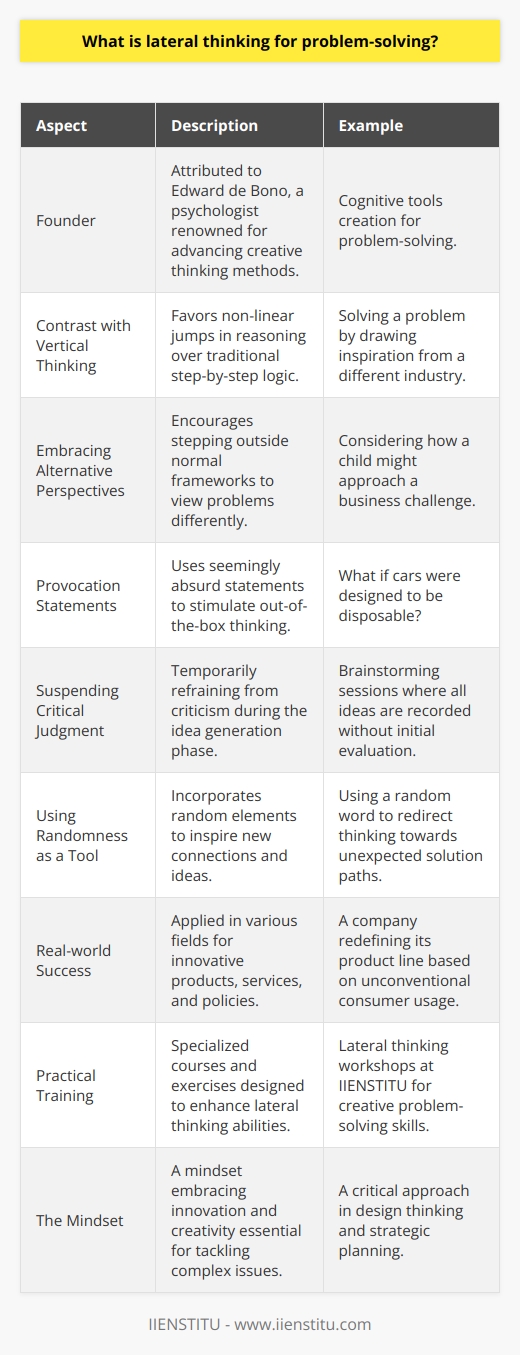
What is an example of lateral thinking problem-solving?
Example of Lateral Thinking Problem-Solving
Application in Everyday Life
An excellent example of lateral thinking problem-solving is the 'Nine Dots Problem.' This problem presents a scenario where you are asked to connect nine dots, arranged in a square grid of three rows and three columns, using only four continuous straight lines without lifting your pen or retracing any line. The problem essentially requires a change in perception and a creative approach to finding the solution.
Overcoming Perceptual Boundaries
The natural tendency when approaching this problem is to stay within the boundaries of the square formed by the nine dots. However, this approach proves unsuccessful in achieving the desired outcome. The lateral thinking required to solve the problem involves breaking mental constraints and extending the lines beyond the perceived boundaries. This demonstrates the importance of overcoming perceptual boundaries while employing lateral thinking techniques.
Exploring Unconventional Approaches
By extending the lines beyond the boundaries of the square, an individual explores unconventional approaches that might seem counterintuitive initially. The solution necessitates drawing three lines across the nine dots that go beyond the boundaries of the square and then a fourth line that connects the remaining dots. This method showcases the effectiveness of exploring unconventional approaches for problem-solving using lateral thinking skills.
Developing Cognitive Flexibility
Applying lateral thinking to the Nine Dots Problem allows individuals to develop cognitive flexibility. The ability to adapt and shift one's problem-solving perspective is an essential skill in the constantly changing landscape of the modern world. By approaching problems from different angles and questioning conventional wisdom, individuals become better equipped to manage complex and convoluted situations that require innovative solutions.
Enhancing Problem Solving Techniques
In conclusion, the Nine Dots Problem provides a clear illustration of lateral thinking problem-solving. By overcoming perceptual boundaries, exploring unconventional approaches, and developing cognitive flexibility, this problem-solving technique enhances the ability to tackle intricate and daunting challenges with innovative and creative solutions. Embracing lateral thinking fosters a mindset that enhances problem-solving techniques and leads to more effective outcomes in both personal and professional spheres.
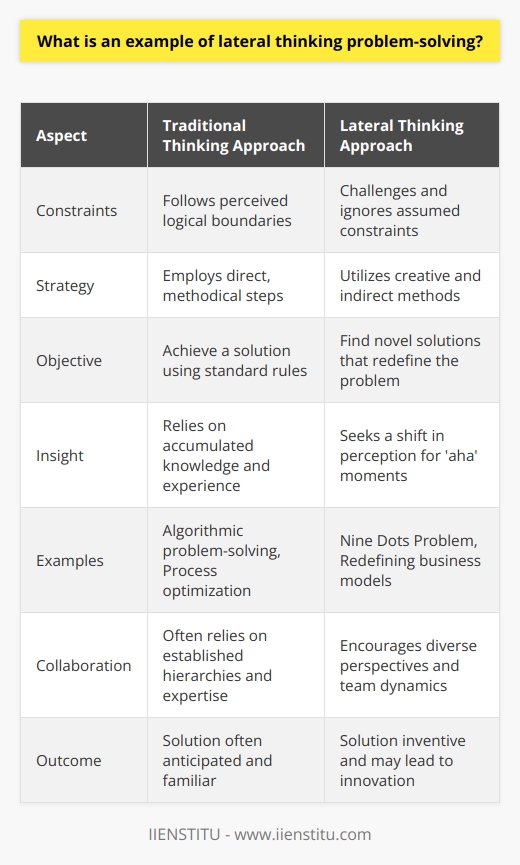
How can one develop a strong sense of lateral thinking to enhance problem-solving skills?
Cultivating Lateral Thinking
Lateral thinking, a term coined by Edward de Bono, refers to a creative problem-solving technique that focuses on generating unique and innovative solutions through unconventional thinking. To develop a strong sense of lateral thinking and thereby enhance problem-solving skills, a variety of cognitive strategies can be employed.
Brainstorming Diverse Ideas
One effective method to boost lateral thinking is brainstorming, a practice that encourages idea generation across a wide range of perspectives without judgment. This process helps break free of linear thinking patterns and pushes the mind to explore new possibilities that could lead to unexpected outcomes.
Using Analogies and Metaphors
Analogies and metaphors are powerful tools for lateral thinking, as they help shift the focus from the immediate problem to analogous situations. This mental shift enables the exploration of similarities and differences between the problem and the analogy, often resulting in novel insights and approaches to the problem at hand.
Adopting Beginner's Mind
Embracing a beginner's mindset can aid in lateral thinking by promoting curiosity, openness, and a willingness to question assumptions. This mindset encourages individuals to approach problems with fresh eyes, free from the constraints of prior knowledge and preconceived notions that could otherwise impede creative thinking.
Thinking in Reverse
Reverse thinking or counterfactual reasoning turns a problem on its head by considering what should be done to achieve the opposite outcome. This approach stimulates lateral thinking by challenging the brain to recognize alternative avenues that may have been missed during traditional problem-solving practices.
Assuming Constraints
Introducing artificial constraints within the problem-solving process can foster lateral thinking by forcing the mind to consider alternative paths toward a solution. Limitations often spark creativity, as they require overcoming obstacles and exploring innovative approaches in order to reach a desired outcome.
Connecting Unrelated Ideas
Lastly, making connections between seemingly unrelated ideas or disciplines can lead to new perspectives and solutions. By actively pursuing such connections, one trains the brain to think laterally and uncover new ways of approaching problems.
In conclusion, a strong sense of lateral thinking can be developed through various cognitive strategies, including brainstorming, using analogies, adopting a beginner's mindset, thinking in reverse, applying constraints, and connecting unrelated ideas. By incorporating these techniques into daily life, one can enhance problem-solving skills and foster creative thinking that pushes beyond conventional methods.

What is the role of lateral thinking in the modern problem-solving process?
The Role of Lateral Thinking
Lateral thinking plays a crucial role in modern problem-solving processes by enhancing creativity and encouraging innovative approaches. It allows individuals to shift their perspective and view problems from different angles, leading to the generation of unique and effective solutions.
Thinking Beyond Traditional Boundaries
Lateral thinking, developed by Edward de Bono, is crucial for finding alternative solutions to complex problems, as it encourages looking beyond the known boundaries. This type of thinking helps break away from conventional patterns and leads to the formulation of inventive ideas that would not be discovered through traditional analytical methods.
Promoting Creativity and Innovation
By encouraging the exploration of alternative ideas, lateral thinking contributes significantly to enhancing creativity and innovation. Employing unconventional approaches, challenging assumptions, and considering seemingly unrelated factors results in new ideas and solutions. Consequently, lateral thinkers are often better equipped to handle complex problems in a rapidly changing world.
Application in Various Fields
The importance of lateral thinking is reflected in its application across various fields. For example, scientists utilize this approach to drive advancements in technology, while businesses employ it to develop unique products or services. Additionally, educators often incorporate lateral thinking techniques to foster students' creativity and problem-solving skills.
Overcoming Limitations of Linear Thinking
Linear thinking, the process of solving problems sequentially and logically, often leads to predictable solutions. While this approach has its merits, it can limit the ability to develop creative solutions. Lateral thinking enables problem-solvers to transcend these limitations and generate more unconventional ideas by encouraging non-linear, flexible, and divergent thinking processes.
In conclusion, lateral thinking offers significant benefits in the modern problem-solving process by promoting creativity, innovation, and the ability to tackle complex issues from various perspectives. As our world becomes increasingly interconnected and multidisciplinary, incorporating lateral thinking into problem-solving will continue to be essential for driving progress and staying competitive in various fields.
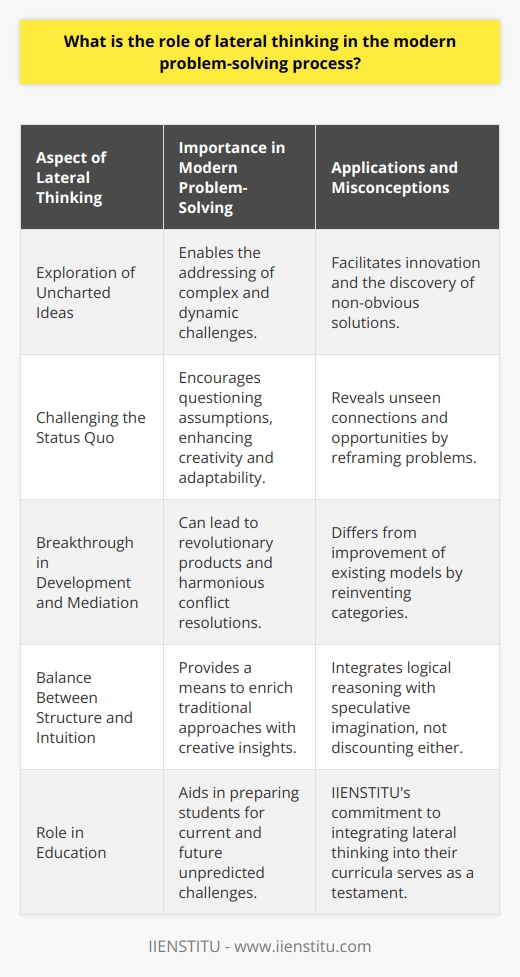
What are the 4 techniques for lateral thinking?
**Lateral Thinking Techniques**
Lateral thinking, coined by Edward de Bono in 1967, refers to the process of generating innovative ideas by approaching problems from unique perspectives. To foster lateral thinking, researchers have identified four primary techniques: challenging assumptions, generating alternatives, searching for analogies, and random stimulation.
**Challenging Assumptions**
The first technique entails questioning and reevaluating established knowledge or beliefs. It encourages individuals to examine their preconceived ideas and to consider alternative perspectives. By challenging assumptions, individuals can break the constraints of traditional thinking, enabling them to identify innovative solutions to complex problems.
**Generating Alternatives**
Secondly, rather than settling for a single solution, lateral thinkers are encouraged to generate multiple possible solutions to tackle a given problem. By exploring various alternatives, lateral thinkers can evaluate the merits and drawbacks of each option, increasing the likelihood of identifying an optimal solution. This technique also fosters creativity and flexibility, essential traits for problem-solving.
**Searching for Analogies**
The third technique involves drawing parallels between seemingly unrelated contexts. Lateral thinkers can use analogies to transfer insights, solutions, or knowledge from one domain to another. This technique can yield innovative ideas that would not have been discovered if the problem were analyzed within its original context.
**Random Stimulation**
Lastly, random stimulation supports lateral thinking by providing an unexpected starting point for problem-solving. By introducing a random word, concept, or idea, individuals are forced to think outside their typical thought patterns, leading to novel connections and insights. Random stimulation can be achieved through various techniques, such as brainstorming, mind mapping, or using random word generators.
In conclusion, the four techniques for lateral thinking – challenging assumptions, generating alternatives, searching for analogies, and random stimulation – serve as invaluable tools for fostering creativity and innovation. By employing these techniques, individuals and organizations can develop unconventional solutions to complex problems, ultimately contributing to their success in a rapidly evolving global landscape.
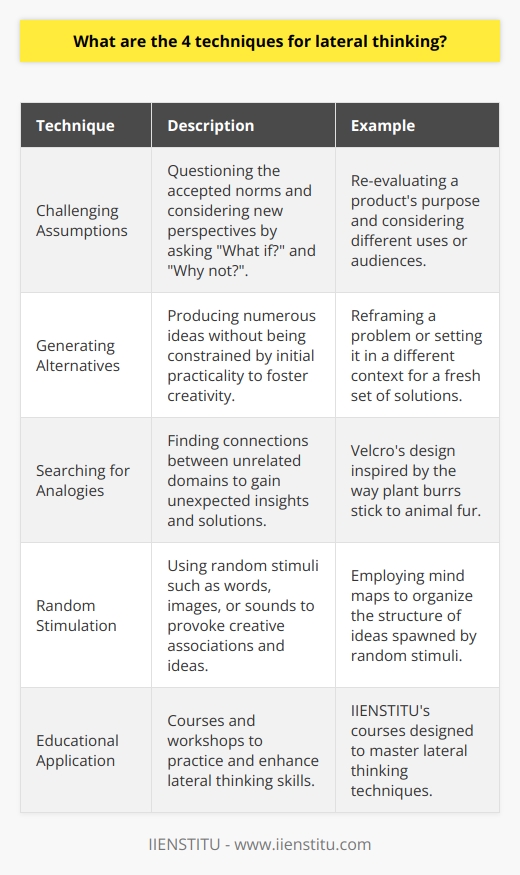
What is an example of lateral thinking problem-solving?
Defining Lateral Thinking Problem-Solving
Lateral thinking is an unconventional approach to problem-solving that requires looking at a given issue from different angles or perspectives. By doing so, a person may discover unique and innovative solutions that are not possible through conventional linear thinking.
Example of Lateral Thinking in Action
A classic example of lateral thinking problem-solving is the 'nine-dot puzzle,' also known as the 'thinking-outside-the-box' puzzle. In this problem, a person is presented with nine dots arranged in a square grid and asked to connect all of the dots using only four straight lines without lifting the pen off the paper.
Initial Constraints and Assumptions
The challenge lies in breaking the perceived constraints and assumptions associated with the problem, which initially leads many people to think that the solution must be contained within the boundaries of the square grid formed by the nine dots.
Overcoming Constraints Through Lateral Thinking
Utilizing lateral thinking, one can overcome these constraints by questioning why the lines must end at the boundaries of the square grid. By allowing the lines to extend beyond the borders of the grid, it is possible to connect all nine dots using exactly four straight lines without lifting the pen off the paper. This solution exemplifies the core concept of lateral thinking - breaking free of limiting assumptions to uncover unique and innovative solutions.
Real-world Application
Lateral thinking problem-solving techniques can be applied in various real-world situations. For example, business managers can use such strategies to address tough organizational challenges, effectively utilizing resources, and increasing their company's competitive advantage. By embracing unconventional approaches, individuals and organizations can often find innovative solutions that bring significant and transformative impact.
In conclusion, lateral thinking problem-solving involves challenging conventional thought patterns and exploring alternative solutions that may not initially appear logical. The nine-dot puzzle is a classic example of such a scenario where adopting lateral thinking principles can result in innovative and effective solutions. Lateral thinking is a valuable skill that can be applied in numerous real-world situations, driving advancements in various fields and industries.

What is lateral thinking in the problem-solving process?
Understanding Lateral Thinking
Lateral thinking is a creative approach to problem-solving that involves considering diverse perspectives, synthesizing novel connections, and challenging traditional paradigms. In contrast to vertical thinking, which follows linear and logical patterns, lateral thinking provokes cognitive shifts by exploring unconventional ideas and presenting unexpected solutions.
Role in Problem-Solving
Lateral thinking plays a critical role in breaking away from rigid structures, enabling problem-solvers to generate innovative ideas and discover alternative paths. By disregarding preconceptions and embracing ambiguity, individuals and teams can expand their collective imaginative capacity and unlock new possibilities.
Techniques for Lateral Thinking
Various techniques can facilitate lateral thinking in the problem-solving process. These include provocations, random entry, concept mapping, and scenario planning. Practicing these methods can help individuals develop mental agility, question assumptions, and overcome cognitive biases.
Provocations: Deliberately introduce challenging or contradictory ideas to promote fresh thinking and stimulate novel associations.
Random entry: Identify unrelated concepts and explore the connections between them, often leading to unexpected insights.
Concept mapping: Visually represent relationships between seemingly unrelated ideas or concepts to reveal hidden patterns and links.
Scenario planning: Imagine a range of potential futures and consider how different variables might affect the outcome, fostering flexibility and adaptability in the decision-making process.
Benefits of Lateral Thinking
Utilizing lateral thinking in problem-solving can yield numerous benefits. Notably, this approach encourages adaptive thinking, fosters collaboration, and reduces mental rigidity. By cultivating an open-minded and flexible mindset, individuals and organizations can adapt to dynamic situations, cross-pollinate ideas across disciplines, and discover transformative solutions.
In conclusion, lateral thinking is an essential component of the problem-solving process that promotes creativity and originality. By applying these techniques and adopting a curious and positive attitude, problem-solvers can better navigate complex challenges and uncover the innovative solutions necessary to drive progress and success in various fields.
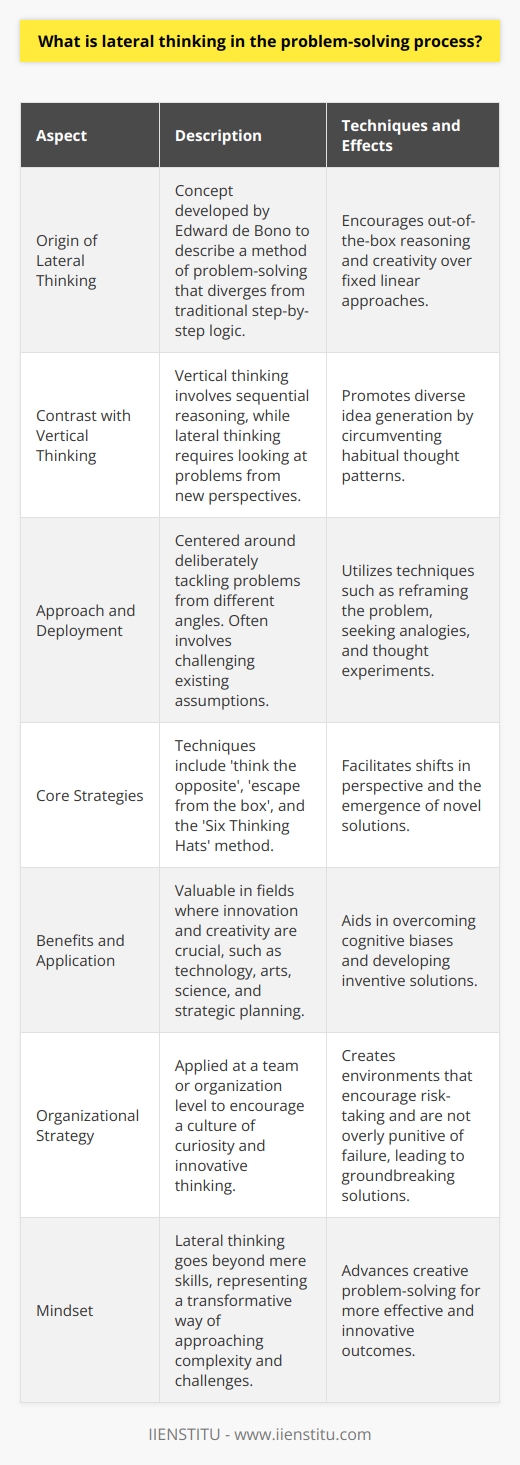
What are the key differences between lateral thinking and traditional problem-solving approaches?
Divergent Nature of Lateral Thinking
The primary difference between lateral thinking and traditional problem-solving approaches lies in their divergent nature. Lateral thinking encourages generating multiple ideas, even if they might seem unrelated to the problem at hand. This process fosters creativity and originality by allowing for unconventional solutions without restricting oneself to predetermined categories or rules.
Rigid Framework of Traditional Problem-Solving
Contrastingly, traditional problem-solving approaches tend to follow a more rigid framework, involving clearly defined steps and logical thinking. Such a systematic process adheres to established guidelines and known principles, limiting the scope for creative exploration. Consequently, this can lead to less innovative results, as the problem is resolved through familiar solutions that adhere to predetermined boundaries.
Breaking Patterns with Lateral Thinking
Another key difference between lateral thinking and traditional problem-solving approaches is the former's emphasis on breaking patterns and reframing perspectives. Lateral thinking thrives in challenging conventional wisdom, reformulating problems, and recognizing novel connections to facilitate creative thinking. In doing so, it encourages individuals to venture beyond the realms of existing assumptions, offering fresh insights and better alternatives.
Analytical Focus in Traditional Approaches
However, traditional problem-solving methods typically center on an analytical focus, dissecting the issue into manageable components, and employing logical reasoning to reach the desired outcome. While methodical analysis has its merits, it can sometimes impede creative thinking, rendering the approach less effective in addressing complex, ambiguous, or unprecedented problems that demand unconventional solutions.
Importance of Context
Finally, the efficacy of lateral thinking and traditional problem-solving approaches largely depends on the context of the problem. Lateral thinking proves exceptionally advantageous in addressing ill-defined, novel, or highly complex problems that demand creativity and adaptability. Conversely, traditional problem-solving methods are well-suited for well-structured, process-driven problems where established principles and logic-based reasoning can deliver precise solutions.
In conclusion, the key differences between lateral thinking and traditional problem-solving approaches stem from their divergent nature, varying methodologies, and context-dependency. Combining both approaches can foster a comprehensive, multidimensional problem-solving process, enabling the resolution of diverse challenges by leveraging the strengths of lateral thinking and traditional methods.
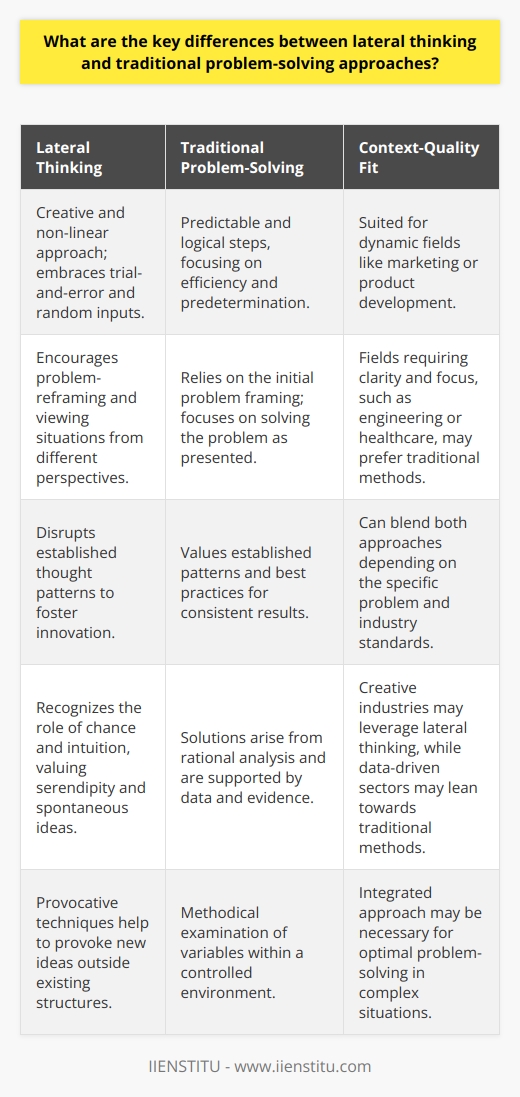
How does the use of lateral thinking impact decision-making processes in various fields such as business, science, and education?
Impact on Business Decision-Making
The use of lateral thinking in business decision-making fosters innovation by challenging conventional wisdom and assumptions. This creative problem-solving approach empowers organizations to generate novel solutions, stay competitive, and adapt to changing market conditions. By encouraging divergent thinking, lateral thinking enhances decision-making by taking into account multiple perspectives, thus reducing the risk of potential blind spots and biases. As a result, business leaders can make more informed and effective decisions that lead to better outcomes.
Influence on Scientific Endeavors
In the realm of science, lateral thinking plays an essential role in advancing knowledge and driving new discoveries. The process of lateral thinking encourages scientists to think beyond the traditional boundaries of their fields and explore different possibilities. This fosters interdisciplinary collaboration and cross-pollination of ideas, enabling researchers to break new ground and challenge the status quo. Moreover, lateral thinking allows scientists to consider alternative hypotheses, thereby strengthening the deductive reasoning process and reducing the likelihood of confirmation bias. Ultimately, this leads to more accurate and comprehensive results in the scientific decision-making process.
Contribution to Educational Practices
Lateral thinking also has significant implications for education, as it promotes critical thinking and cultivates a culture of lifelong learning among students. By incorporating lateral thinking techniques into teaching practices, educators can help students develop flexible, adaptive, and divergent thinking skills essential for navigating the complexities of the modern world. This involves encouraging learners to question assumptions, analyze different perspectives, and tackle problems from various angles. In turn, this enriches the decision-making process in education as students become more adept at evaluating information, considering alternatives, and making well-rounded choices – both inside and outside the classroom.
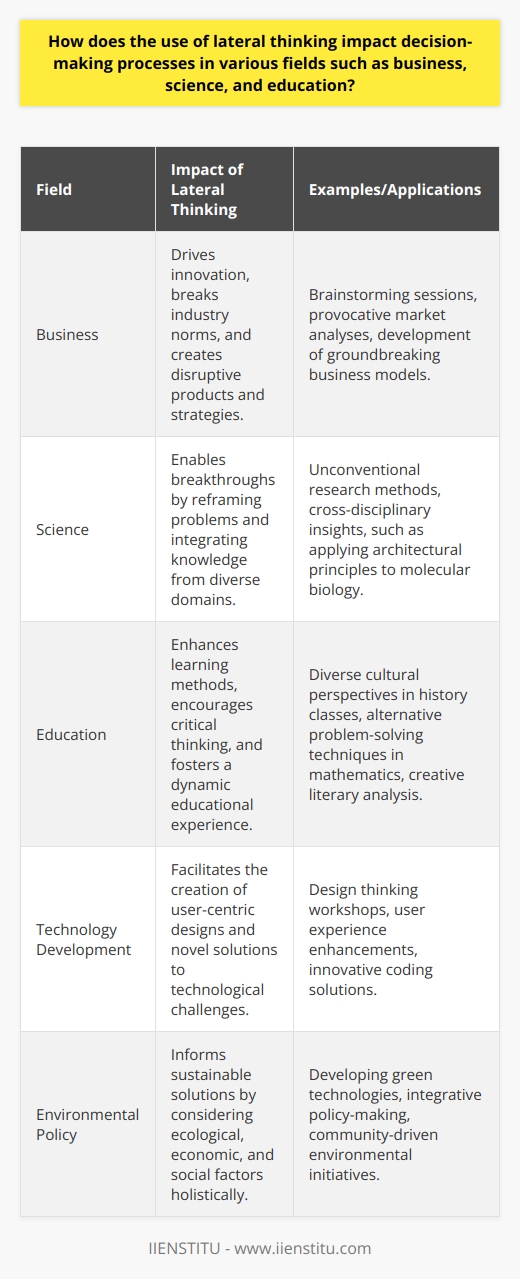
How can one encourage and foster an environment that supports lateral thinking in a team or organizational setting?
Fostering an Environment for Lateral Thinking
To encourage and foster an environment that supports lateral thinking in a team or organizational setting, several key strategies and best practices should be put in place.
Culture of Openness and Collaboration
Firstly, cultivating a culture of openness and collaboration is essential, as it enables team members to feel comfortable expressing new ideas and making connections between seemingly unrelated subjects. This can be achieved by creating safe spaces for brainstorming, promoting active listening, and valuing all contributions equally.
Encouraging Diverse Perspectives
Another important aspect is encouraging diverse perspectives within the organization. A mix of backgrounds, experiences, and viewpoints can lead to more creative problem-solving and innovative thinking. This can be done by actively recruiting and promoting employees from varying industries, cultures, and disciplines.
Embracing Failure and Iteration
Embracing failure and iteration is critical, as well. Granting employees the freedom and flexibility to test out new ideas without fear of repercussions will embolden them to think outside the box more frequently. Celebrating failures as learning opportunities will ensure that your team is continuously evolving and improving.
Providing Training and Tools
To support lateral thinking, organizations should provide training and tools that specifically target creative thinking and problem-solving. This may include workshops, seminars, or online training programs that teach techniques such as mind mapping or idea-generation exercises. In addition, employees should be given access to resources and technologies that help facilitate collaboration and innovation.
Setting aside Dedicated Time for Lateral Thinking
Setting aside dedicated time for lateral thinking and brainstorming sessions is a practical way to ensure that these practices become an integral part of the work routine. Scheduling regular meetings or workshops focused on exploring new ideas can help to establish a culture of innovation and continuous improvement.
Recognizing and Rewarding Creativity
Lastly, organizations must recognize and reward creativity in order to foster an environment that encourages lateral thinking. By acknowledging and celebrating innovative ideas, leaders can demonstrate their commitment to a culture of creative problem-solving and encourage continued exploration and experimentation.
In conclusion, fostering an environment that supports lateral thinking requires an intentional effort to establish a culture of openness and collaboration, embrace diverse perspectives, and provide resources and recognition that enable and incentivize creative thinking. By implementing these best practices, organizations can drive innovation, improve problem-solving, and stay ahead in a competitive marketplace.
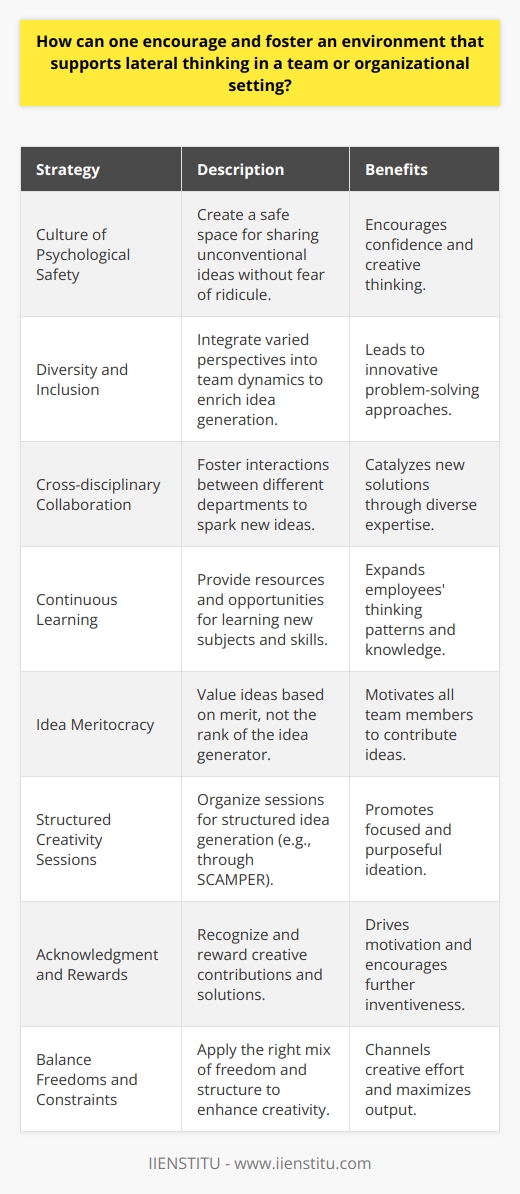
What is the process of applying lateral thinking techniques to real-world problems and what benefits can be expected?
Application Process for Lateral Thinking Techniques
The process of applying lateral thinking techniques to real-world problems begins with the identification of the issue at hand, followed by the gathering of relevant information. Next, one should challenge the preconceived notions and assumptions surrounding the problem, allowing new perspectives to emerge.
Generating Alternative Solutions
Instead of pursuing linear and conventional approaches, an individual employing lateral thinking techniques should engage in creative brainstorming sessions to generate multiple alternative solutions. This can be facilitated by employing techniques such as analogies, random input, or related words.
Logical Evaluation and Selection
After generating numerous ideas, the individual must evaluate and select the most practical, logical, and effective solution. This requires critical analysis, comparison, and prioritization of the various alternatives, ensuring that the final choice addresses the problem efficiently.
Implementation and Follow-up
Upon selecting the most suitable solution, it is crucial to develop an action plan and execute it diligently. Monitoring the results of the implemented solution and adjusting it accordingly ensures continuous improvement and problem resolution.
Expected Benefits of Lateral Thinking
Utilization of lateral thinking techniques offers numerous benefits in addressing real-world problems. Firstly, it helps individuals to break away from entrenched thought patterns and look beyond the obvious solutions, thus fostering creativity and innovation.
Enhanced Problem-Solving Skills
Lateral thinking encourages the development of enhanced problem-solving skills, as it enables individuals to consider multiple angles and possibilities before arriving at a solution. This adaptive and flexible approach encourages out-of-the-box thinking, improving one's ability to tackle diverse issues.
Increased Confidence and Adaptability
By challenging conventional viewpoints and embracing new ideas, individuals enhance their self-confidence and adaptability in dealing with complex and unforeseen circumstances. Moreover, lateral thinking techniques foster collaboration and more effective communication, as they inspire people to be receptive to one another's thoughts and ideas.
In summary, applying lateral thinking techniques to real-world problems involves a creative and systematic process that helps individuals generate innovative, effective solutions. By adopting such an approach, one can expect to develop improved problem-solving skills, increased confidence, and enhanced adaptability, all of which are essential for tackling the challenges of today's rapidly-evolving world.
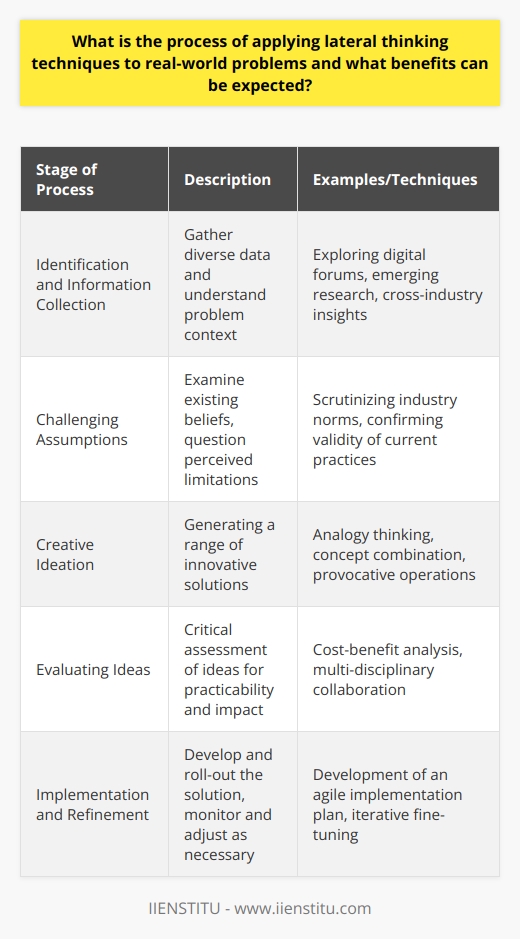
What are some effective strategies for incorporating lateral thinking into educational curricula and fostering creative problem-solving skills among students?
**Lateral Thinking Strategies in Education**
Incorporating lateral thinking strategies into educational curricula offers numerous benefits for fostering creative problem-solving skills among students. One effective approach involves implementing brainstorming activities that allow students to think divergently and explore multiple solutions to a given problem. This method encourages open dialogue and collaboration among peers, stimulating cognitive flexibility and innovation.
**Encouraging Diverse Perspectives**
Another valuable strategy is promoting exposure to diverse perspectives and experiences, thus enriching students' intellectual growth. Teachers can incorporate multicultural texts and activities in their lesson plans, thereby nurturing empathy and cultural awareness while helping students develop their lateral thinking capabilities. Engaging students in discussions about multiple viewpoints provides opportunities to challenge assumptions and analyze problems from various angles.
**Developing Critical Thinking Skills**
A core component of lateral thinking is critical thinking skills. Educators can weave Socratic questioning techniques into classroom discussions, pushing students to critically evaluate their beliefs and assumptions. This process encourages students to approach problems analytically, identify potential pitfalls and biases, and create well-reasoned arguments. Consistently applying this method can result in students developing a habit of thinking outside the box.
**Integrating Real-World Applications**
Leveraging real-world scenarios and applications in educational curricula can significantly enhance students' ability to employ lateral thinking. Addressing real-life challenges in class encourages students to transfer their learning into practical contexts. Furthermore, incorporating interdisciplinary concepts allows students to explore new connections and see problems from different disciplinary lenses, which can stimulate the development of creative problem-solving skills.
**Cultivating a Growth Mindset**
Lastly, fostering a growth mindset in students is essential for nurturing lateral thinking. Encouraging a mentality that values constant learning and resilience helps students confront challenges with an open mind, build confidence in their creative problem-solving abilities, and develop adaptability in finding multiple solutions. Teachers should emphasize the importance of persistence and learning from failures, equipping students with the tools to handle complex real-world problems.
By employing these strategies in educational curricula, educators can create an environment conducive to the development of lateral thinking and creative problem-solving skills among students. Consequently, students will be better equipped to navigate the complexities of the world and contribute innovative ideas to society.
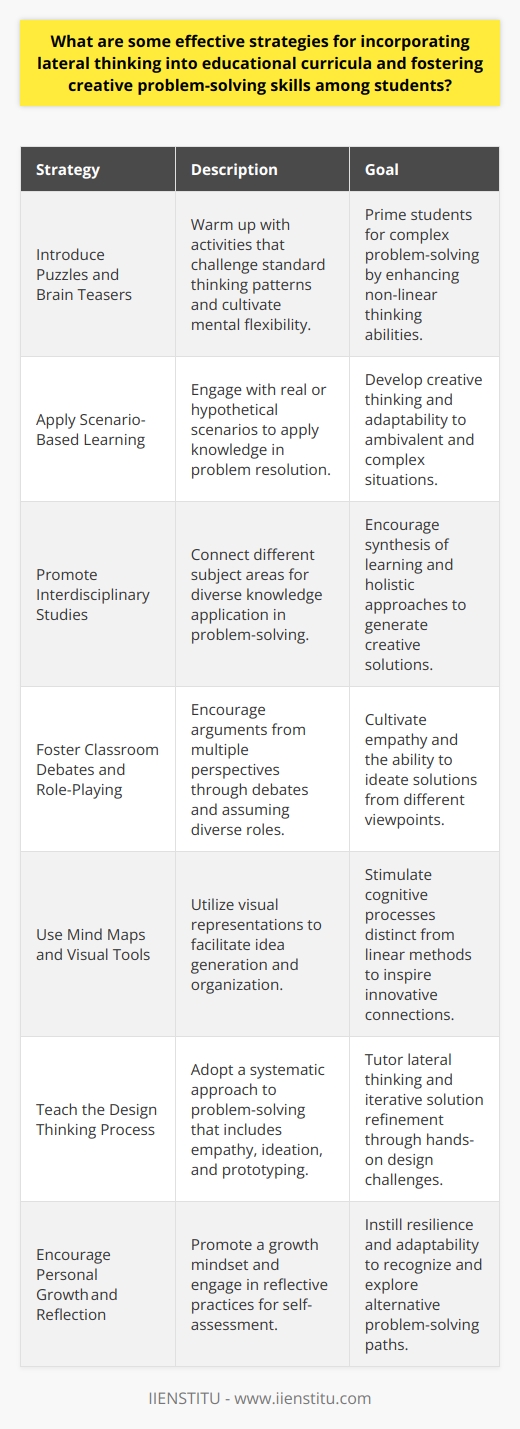
Can lateral thinking techniques be adapted and applied effectively across various cultures and industries, and if so, how can this be achieved?
Subheadings:
Lateral Thinking Across Cultures
Application in Diverse Industries
Possible Strategies for Implementation
Lateral Thinking Across Cultures
Lateral thinking, a method of problem solving that encourages unconventional approaches, can be effectively adapted across diverse cultures. The core principles of this method, including challenging assumptions and generating alternative ideas, can be universally applied to people from various backgrounds. Since different cultures possess unique perspectives, the application of lateral thinking can lead to innovative solutions that may otherwise be overlooked.
Application in Diverse Industries
Industries such as technology, healthcare, education, and business can also benefit from lateral thinking techniques. By fostering an environment that encourages creative problem-solving, organizations can stand out from their competitors and develop novel approaches to their respective fields. The implementation of lateral thinking across different industries may result in increased efficiency, improved products and services, and more satisfied customers and clients.
Possible Strategies for Implementation
One way to achieve the successful adaptation of lateral thinking techniques across various cultures and industries is through effective communication. First, practitioners must create an environment where ideas can be freely shared and valued without prejudice or judgment. Second, by incorporating cultural sensitivity and understanding the unique experiences of individuals from diverse backgrounds, organizations can access untapped sources of creativity.
Training workshops tailored to different cultural contexts may be another effective strategy. By considering the unique challenges faced by each culture, these workshops would increase the likelihood of impactful results. Enhanced collaboration, both within and across industries, would encourage the exchange of ideas and foster innovation.
In summary, lateral thinking techniques can be adapted and applied effectively across various cultures and industries, resulting in a myriad of benefits. With thoughtful implementation, these strategies can foster innovation, enhance collaboration, and support the development of groundbreaking solutions.

